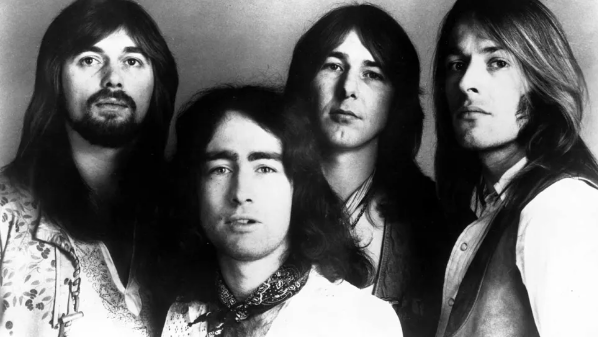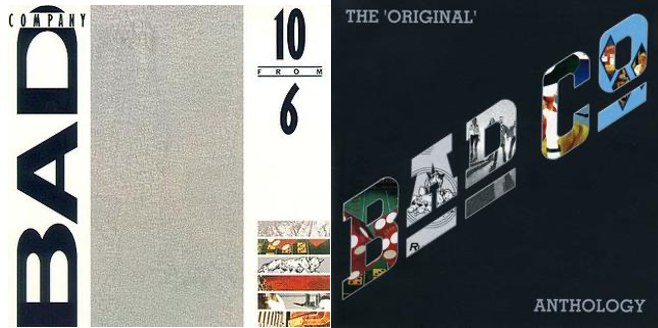
Bad Company, arguably the fourth British supergroup (after Cream, Blind Faith and Emerson, Lake and Palmer) ruled the charts and concert halls for much of the 1970s. Unlike those Clapton-based groups, the band released multiple albums. (Six in total.) Hooking up with Led Zeppelin’s manager, Peter Grant, the band was a hit from the word go, scoring a Billboard #1 album their first album.
Unfortunately, like ELP, their albums grew weaker as time passed. In fact, the original incarnation of the band (Paul Rodgers and Simon Kirke from Free, Mick Ralphs from Mott the Hoople and Boz Burrell from King Crimson) hold a rare distinction in rock; every album declined in quality, being not as great than the previous one, making it a band whose catalog diminished with every new release.

Here, I’m going to rank the six “original” Bad Company albums – the ones with the classic lineup (Rodgers, Ralphs, Kirke and Burrell) – ignoring the Brian Howe era, which, although not a commercial failure, did nothing but sully the good name of Bad Company from its inception in 1986 and beyond.
Rough Diamonds
Released 1982
Highest Chart Peak: 26
Standout Track: “Electricland”
6/6

Released August 1982, Bad Company’s final album, Rough Diamonds, is also its weakest. It came along three years after the previous outing, Desolation Angels, a gap that showed them how out of touch the band was. By the time its lone radio track, “Electricland,” hit the airwaves of FM radio, it was fighting for airtime along with the “new rock” of Men at Work, Missing Persons, and A Flock of Seagulls, unlike three years earlier when the band was up against now-departed counterparts such as Led Zeppelin, the Eagles, and The Knack.
Maybe the album would’ve done better if the songwriting was more memorable. The band sounds like it’s going through the motions, simply putting out an album because they don’t know what the hell else to do. To be fair, manager Grant has secluded himself after John Bonham died, and to be sure, the drugs, alcohol and stress didn’t make things any better. There was no 1982-1983 Bad Company tour, and the group quietly disbanded without any sort of formal announcement. Rough Diamonds is the sound of a band that was too tired to carry on.
Fun fact (could there possibly be anything fun about this album?): The album sat in the can for well over a year before it was released. (If Wikipedia is accurate!)
Desolation Angels
Released 1979
Highest Chart Peak: 3
Standout Track: “Rock ‘n’ Roll Fantasy”
5/6

A comeback (commercially, at least) for the band; this album peaked at #3, mostly due to its monster hit lead-off track, “Rock ‘n’ Roll Fantasy.” Which is an all-time classic for the band – but unfortunately, the rest of the album is reasonably dull. (Just not quite Rough Diamonds dull.) But the album/song had enough juice to get the band out of its slump, and back on the radio in style. To be fair, this album could be swapped with Burnin’ Sky in this list – however, Sky doesn’t have the ups and downs (mostly downs) that this one does, as it remains a consistent listen all the way through. The Hipgnosis cover – similar to those on contemporary albums by UFO and Led Zeppelin – wasn’t one of the art collective’s best works.
Fun fact: Alison Krauss recorded a cover of Desolation Angels “Oh, Atlanta” in 1995.
Burnin’ Sky
Released 1977
Highest Chart Peak: 15
Standout Track: “Burnin’ Sky”
4/6

The fourth album in four years, Burnin’ Sky is where the cracks start showing. Unlike albums two & three, which only fell a bit down in quality from the previous release, this one falls further downhill than those that proceeded it. Which is fully understandable in the days of the album/tour cycle repeated every year, as was the norm in that era. While there is nothing terribly wrong here (aside from the unnecessary silliness of “Knapsack”), there aren’t those strong standout tracks we’ve come to expect from the band. What seemed at the time as a slight dip in quality was, unfortunately, a harbinger of things to come.
Fun fact: The cover art was based on the poster from the 1969 film, The Wild Bunch.
Run With the Pack
Released 1976
Highest Chart Peak: 5
Standout Track: “Run With the Pack”
3/6

The third album in as many years was also the first one that lacked at least one big classic tune. Despite the fact that all the tracks are reasonably strong for the most part, it certainly doesn’t hold up to the first two albums. Oddly enough, it was also the first time (and only, other then the aforementioned “Knapsack”) that the band recorded a cover version – “Young Blood” (which strangely became a top twenty hit single). Although it contains “Silver, Blue and Gold” and “Live For The Music,” these two songs just didn’t have the staying power of some of the tracks on the earlier albums. Not a bad album by any stretch – just not a classic like the first two. After two albums festooned with timeless rock classics, Run With The Pack is the band’s Led Zeppelin III.
Fun fact: Pack Engineer Ron Nevison later hit pay dirt in the mid-1980s, producing platinum albums from Survivor, Heart, and Ozzy Osbourne.
Straight Shooter
Released 1975
Highest Chart Peak: 5
Standout Track: Shooting Star
2/6

The band’s second album (both chronologically and in greatness), Straight Shooter picked up right where its predecessor left off, not an easy feat considering the impact (both artistically and commercially) of the debut. Hitting the ground running with its two lead tracks (“Good Lovin’ Gone Bad” and “Feel Like Makin’ Love”), the band proved that it wasn’t a one-hit wonder and could deliver the goods the second time around, which usually wasn’t the case for most bands that released a #1 debut. (The Knack, Asia, and The Go-Go’s, call your office.). Straight Shooter is a mighty album – just one classic song away from being as good as the debut.
Fun fact: Straight Shooter was one of two albums (the other being the debut) that didn’t feature a Boz Burrell writing credit.
Bad Company
Released 1974
Highest Chart Peak: 1
Standout Track: All of Them!
1/6

One of the stellar albums of the classic rock era. Five of its eight tracks remain FM radio standards to this day. Listen to the album – there’s nothing else to say about this monster debut!
Fun fact: Mick Ralph’s “Ready for Love” was originally recorded by Mott the Hoople on the All The Young Dudes album.
Furthermore:

In addition, the band released a few compilation albums; most notably, 1985’s mistitled 10 From 6 (whose ten songs supposedly are from the original six albums, although no tracks from Burnin’ Sky were present) and 1999’s fantastic The Original Bad Company Anthology (which was followed by a short, if not entirely successful reunion tour), whose four new tracks can be tolerated, because the collection includes non-album B-Sides, unreleased material, and alternate takes. Along with Cheap Trick’s Sex America Cheap Trick and The Cars’ Just What I Needed collections, one of the most tremendous compilations from a classic rock band.